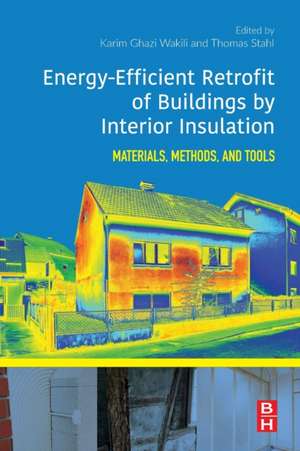Energy-Efficient Retrofit of Buildings by Interior Insulation: Materials, Methods, and Tools
Editat de Thomas Stahl, Karim Ghazi Wakilien Limba Engleză Paperback – 25 noi 2021
The practical approach of the book, with examples in all chapters, makes it valuable for Civil and Architectural Engineers involved with building retrofit. The book may also be useful to researchers in the field of Building Physics due to the breadth of the coverage.
- Introduces methods and tools through application examples
- Presents theory and simulations with practical information to validate models
- Explores a wide variety of materials and applications
- Features examples of Residential, Commercial and Historic Buildings
- Covers all stages of the retrofit process, from planning to inspection and how to avoid damage
Preț: 1405.28 lei
Preț vechi: 1544.27 lei
-9% Nou
Puncte Express: 2108
Preț estimativ în valută:
268.91€ • 281.70$ • 222.86£
268.91€ • 281.70$ • 222.86£
Carte tipărită la comandă
Livrare economică 01-15 aprilie
Preluare comenzi: 021 569.72.76
Specificații
ISBN-13: 9780128165133
ISBN-10: 0128165138
Pagini: 518
Dimensiuni: 152 x 229 mm
Greutate: 0.69 kg
Editura: ELSEVIER SCIENCE
ISBN-10: 0128165138
Pagini: 518
Dimensiuni: 152 x 229 mm
Greutate: 0.69 kg
Editura: ELSEVIER SCIENCE
Public țintă
Civil engineers, Architects, local authorities, town councils, building owners, consulting engineers, students, funding bodies, real estate managers, monument conservator, producing companies, building expertsCuprins
Section 1: Materials
1.1. Materials (wood, concrete, brick, natural stones, renewables)
1.2. Peculiarities of using VIP as internal insulation
1.3 Hydrophilic and hydrophobic materials as internal insulations for historic masonry walls
1.4 Historical plasters in connection with thermal insulations
1.5 Advantages and use of a newly developed load-bearing insulation material made of cattail
1.6 Hygric interactions with antigraffiti systems
1.7 Insulating plasters and their use as internal insulation
Section 2: Measurements and Procedures
2.1 Restoration of moisture and salt damaged masonry
2.2 Status analysis and building diagnosis prior to the application of internal insulation; practical implementation of the results obtained; some examples
2.3 Influence of internal thermal insulation on the sound insulation of walls
2.4 Peculiarities of installing internal insulation in half-timbered walls; detailed solutions; some examples
2.5 In situ measurement of water uptake on facades and its correspondence with internal insulation materials
2.6 Holistic and process approach to internal insulation
2.7 Peculiarities of fire protection in case of internal insulation; fire prevention and fire protection concepts; some examples
2.8 Variations and design options in renovation with internal insulation
2.9 Internally insulating building details in contact with the ground
2.10 Mitigation of structural thermal bridges
2.11 Energy-efficient renovation with internal insulation
Section 3: Simulation and Analysis Tools
3.1 Case study: Near zero energy building
3.2 Hygrothermal behavior of internal insulation systems with component integrated heating elements
3.3 Interior insulation and mold problems
3.4 Comparison of different internal thermal insulation materials with respect to their hygrothermal behavior
3.5 Energy performance evaluation of internal insulation as a measure for the modernization of existing buildings
1.1. Materials (wood, concrete, brick, natural stones, renewables)
1.2. Peculiarities of using VIP as internal insulation
1.3 Hydrophilic and hydrophobic materials as internal insulations for historic masonry walls
1.4 Historical plasters in connection with thermal insulations
1.5 Advantages and use of a newly developed load-bearing insulation material made of cattail
1.6 Hygric interactions with antigraffiti systems
1.7 Insulating plasters and their use as internal insulation
Section 2: Measurements and Procedures
2.1 Restoration of moisture and salt damaged masonry
2.2 Status analysis and building diagnosis prior to the application of internal insulation; practical implementation of the results obtained; some examples
2.3 Influence of internal thermal insulation on the sound insulation of walls
2.4 Peculiarities of installing internal insulation in half-timbered walls; detailed solutions; some examples
2.5 In situ measurement of water uptake on facades and its correspondence with internal insulation materials
2.6 Holistic and process approach to internal insulation
2.7 Peculiarities of fire protection in case of internal insulation; fire prevention and fire protection concepts; some examples
2.8 Variations and design options in renovation with internal insulation
2.9 Internally insulating building details in contact with the ground
2.10 Mitigation of structural thermal bridges
2.11 Energy-efficient renovation with internal insulation
Section 3: Simulation and Analysis Tools
3.1 Case study: Near zero energy building
3.2 Hygrothermal behavior of internal insulation systems with component integrated heating elements
3.3 Interior insulation and mold problems
3.4 Comparison of different internal thermal insulation materials with respect to their hygrothermal behavior
3.5 Energy performance evaluation of internal insulation as a measure for the modernization of existing buildings
